Posted by Elena del Valle on March 5, 2025
This article was written without AI-assisted technologies.
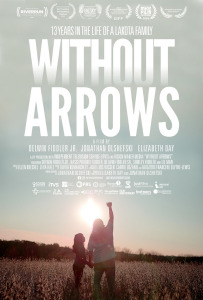
Without Arrows
Photo, video, screener: First Run Features
Following its premiere on PBS Independent Lens First Run Features released Without Arrows, a 93-minute 2025 documentary on moments in the life of a Lakȟóta family. Filmed over 13 years the documentary was scheduled for release February 2025 via Amazon and Apple streaming as well as DVD ($19.95). Scroll down to watch a short video trailer.
The film is in English peppered with words in Lakȟóta. It follows a family over three generations. At times it is difficult to make out the words of their dialogue. It centers on Delwin Fiddler Jr., a champion grass dancer from the Cheyenne River Sioux Tribe, who left his reservation as a young man and built a new life in Philadelphia. Ten years later he returned home to the Cheyenne River Sioux Tribe Reservation in South Dakota to fulfill his mother’s ambition and carry on his extended family’s legacy. Shirley Eagletail Fiddler, his mother, Delwin Fidder, Sr., his father, and his daughter Kassi Phoenix Fiddler are also featured.
Moving and sad at times Without Arrows is also hopeful. Family members appear in everyday settings and at home. Also as the seasons change the documentary features moments of dancing, family gatherings, burials and family conversations. It has an original score by Olivia Komahcheet.
Directed and produced by Elizabeth Day and Jonathan Olshatski Without Arrows received fiscal sponsorship from The Film Collaborative. It was a co-production of ITVS and Vision Maker Media. It also received support from Australian Independence Documentary Conference, Big Sky Pitch, Film Independent Documentary Lab, The Gotham, Hotdocs Deal Maker Program, Hotdocs Forum, Jihlava New Visions Forum, Minnesota Film Festival Pitch Competition; and grants from Ford Just Films, Philadelphia Foundation, Catapult Film Fund, Bertha Foundation, Economic Hardship Reporting Project, and Rowan University. The Corporation for Public Broadcasting and PBS also appear among the film credits.
Posted by Elena del Valle on December 11, 2024
This article was created without AI-assisted technologies.
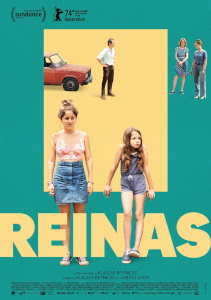
Reinas poster
Photos, video: Outsider Pictures
A 2024 Spanish language film from Switzerland, Peru and Spain Reinas is this year’s Switzerland’s International Film Oscar submission. Set in 1990s Peru the 105-minute film with English subtitles* centers around two sisters and their divorced parents. Driven by a deteriorating political and financial situation in her country Elena (Jimena Lindo) plans to move to Minnesota with Lucia and Aurora, her daughters. In order for them to leave the country Carlos, their absentee father, must sign exit papers. Complications arise as departure time approaches. Scroll down to view a trailer.
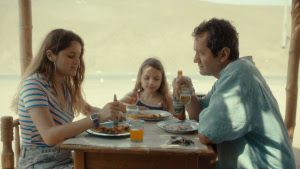
Scene from Reinas with Carlos, Lucia and Aurora
Excellent acting, attention to detail and a credible setting (for someone who has never visited 1990s Peru) made the story immersive. The film received the following recognitions: Winner Best Director, Berlin – Grand Prix, Generations; Winner Audience Award at the Locarno Film Festival; and Official Selection at Sundance. Also starring are Abril Gjurinovic, Gonzalo Molina, Luana Vega and Susi Sanchez. According to promotional materials Klaudia Reynicke-Candeloro, the director, grew up in Lima. The script was by Reynicke-Candeloro and Diego Vega. The producers were Britta Rindelaub, Diego Vega, Valerie Delpierre, Thomas Reichlin and Daniel Vega.
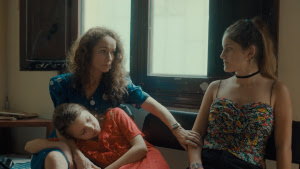
Scene from Reinas with Elena, Lucia and Aurora
Support for the film was from Sundance, Alva Film, Inicia Films, Maretazo Cine, RTS Radio Television Suisse. It was sponsored by Switzerland, Spain, CineForum, Loterie Romande, Department of Culture of Catalunya and Peru among others. Reinas opened in Los Angeles and New York City theaters last month. According to a press release it will be available for online rental and purchase in Spring 2025.
*(the screener was without subtitles)
Posted by Elena del Valle on April 6, 2022
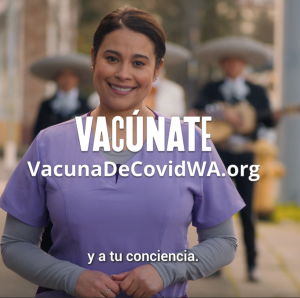
Washington Hispanic market campaign videos link to VacunaDeCovidWA.org
Photo: Tony Teran
Video: Washington State Department of Health
Hoping to reach Hispanics between 18 and 35 years of age hesitant about pandemic vaccines in Washington state with a pro Covid-19 vaccinations message the Washington State Department of Health hired C+C. The Seattle-based marketing agency produced audio and two video spots in Seattle. Production costs for Vacúnate Mijo/a were $168,000 and $205,000 for Mentira Mariachi. The ads were produced for broadcast distribution, YouTube, TikTok and radio. Scroll down to watch videos in English and Spanish (with subtitles).
When C+C conducted the initial research that led to the campaigns’ development, the team found that while most Hispanic people in Washington state were “very willing or somewhat willing” to take a Covid-19 vaccine more English-speaking survey respondents expressed vaccine hesitancy than Spanish speakers. Overall, 62 percent of survey takers said they were very willing or somewhat willing to receive a Covid-19 vaccine; 67 percent of Spanish speakers and 56 percent of English speakers said they were very or somewhat willing to get vaccinated; 2 percent of Spanish speakers who responded to the survey compared to 18 percent of English speakers who responded to it said they would not take the vaccine; 27 percent of Spanish speakers versus 23 percent of English speakers who answered questions said they were unsure; more English speakers than Spanish speakers said they thought Covid-19 vaccines may be unnecessary and ineffective; and more English speakers than Spanish speakers said they had other ways to protect themselves against the virus.
According to a C+C spokesperson the overall goal of the campaigns was “to increase vaccination rates among the Hispanic community in Washington by tackling key research findings. Misinformation on vaccine safety and efficacy was indicated as one of the main drivers of vaccine hesitancy among this community. While protecting themselves, their loved ones, and their community ranked as the main motivation for getting vaccinated.”
The agency addressed concerns about trust in the vaccines with emotional pleas to family ties, Spanish language and Mariachi music. Tony Teran, campaign writer and creative director, C+C, replied by email via an intermediary, “At the center of the Vacúnate Mijo/a campaign is the relationship between a grandchild and a grandmother or abuela, a much loved and nostalgic figure among many Hispanic/Latinx families, often seen as a trusted voice of reason. We follow their bond through different life stages that showcase the core of our message: protecting each other. The Spanish language is also a powerful connecting thread in these ads, as we hear the word mijo/a express different emotions at different times, a word so simple, yet incredibly purposeful. Abuela is saying ‘I care about you’ with every mijo and ultimately encouraging her grandchild to receive the vaccine.
The idea behind the Mentira Mariachi campaign is that we all listen to the voice of our conscience when making decisions. So, what if that voice came accompanied by trumpets and guitarrón, as in traditional Mariachi music, to remind audiences to listen to science and their good judgement, and not to misinformation? The :30 video spot shows a young guy at home. Every time he is exposed to fake news about the COVID-19 vaccines, he’s surprised by a Mariachi band popping out of nowhere to humorously remind him, with a catchy jingle, that those are mentiras (lies). At the end of the spot, we see him coming out of a vaccination site after getting his shot as Mariachi band members give him a nod of approval and a health care worker delivers the campaign’s tagline: ‘Escucha a la ciencia y a tu conciencia.’ (Listen to science and to your conscience.)”
The Vacúnate Mijo/ ad goal was to encourage community members to get vaccinated by emphasizing the importance of protecting their loved ones during the pandemic; while the Mentira Mariachi ad was meant to dissipate vaccine misinformation by encouraging the audience to “trust science.”
According to information provided by C+C the Hispanic population in the state represents 13 percent of the total population, yet in mid-July 2021, had 27 percent of the coronavirus cases, 19 percent of total hospitalizations, and 8.4 percent of total deaths in Washington; about 60 percent of the state’s Hispanic population remained unvaccinated, according to the Washington Department of Health.
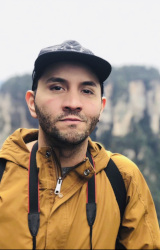
Tony Teran, creative director, C+C
“Creative concepting for both of the campaigns began in August 2021,” Teran replied when asked how many months the campaign project required. “Vacúnate Mijo/a launched in November 2021 while Mentira Mariachi launched in February 2022.
The C+C team used three different types of research when developing the strategy and concept for this Hispanic/Latinx-focused campaign: 1:1 Interviews, since 2020, the team has been conducting monthly 1:1 in-depth interviews with Hispanic/Latinx community members to learn about their overall attitudes, barriers and motivators for getting a COVID-19 vaccine.
Focus Groups, C+C conducted four focus groups with Hispanic/Latinx community members to test the campaign’s creative approach and gain insights into what type of creative would resonate most with the community. A total of 20 community members participated.
Secondary Research, The Washington State Department of Health (DOH) and C+C worked hand-in-hand with partners like the University of Washington’s Latino Center for Health to analyze insights about vaccine hesitancy among the state’s Hispanic/Latinx population that helped shape the campaign, including a report released by the Center in April 2021. The team also referenced findings of COVID-19 surveys conducted regularly by the Bill & Melinda Gates Foundation/Civis Analytics.”
When asked how the agency measured results Teran replied, “We have been correlating the success of the campaigns with the increase in vaccination rates among Hispanic/Latinx adults in Washington. Approximately 63 percent of the Hispanic/Latinx community 18+ in Washington have initiated vaccination as of 3/25. This is up from 49.9 percent in November 2021 before the campaigns launched. This amounts to an increase of 13.1 percent. The overall vaccination gap has also closed by 7.4 percent among the Hispanic/Latinx community. The gap closed on Hispanic/Latinx community vaccination rates from being 29.5 percent behind the overall Washington state rates in November 2021 to only 22.1 percent behind in March 2022.”
The campaigns were developed and produced by a team that included members of Washington state’s Hispanic community, including Terán, the creative of Venezuelan roots behind the original concepts. He wrote the video and audio scripts, and oversaw the campaigns’ production process; featured Hispanic cast member for both campaigns; and the production team selected Spanish speaking talent seeking a cultural fit, and with good acting skills and on-camera presence, according to information provided by C+C.
The Vacúnate Mijo/a production included creative input from Mauricio Valadrian, of Valadrian Creative & Consulting; the Mentira Mariachi video production was co-directed by Marvin Lemus, director of Netflix’s Gentefied, and also a Hispanic creative; the Mentira Mariachi video and audio ads feature an original song written for that campaign by a Hispanic musician and performed on-screen by Tacoma-based Mariachi Ayutla, a mariachi band, according to information provided by C+C.
Mentira Mariachi ad in Spanish
Vacúnate Mijo ad in English
Posted by Elena del Valle on January 24, 2022

Filmmaker Claudia Sparrow
Photo, video: courtesy of Claudia Sparrow
A podcast interview with documentary filmmaker Claudia Sparrow is available in the Podcast Section of Hispanic Marketing and Public Relations, HispanicMPR.com. During the podcast, she discusses Maxima with Elena del Valle, host of the HispanicMPR.com podcast. Scroll down to watch a Maxima trailer in English and Spanish with subtitles.
Claudia was born and raised in Lima, Peru. Her American Film Institute film El Americano won a 2009 Emmy Award in the drama category and she was a recipient of the 2009 Franklin J. Schaffner Fellow Award from the American Film Institute for directing that film.
Claudia’s first feature film I Remember You, starring Stefanie Butler and Joe Egender, premiered at the 2015 Downtown Film Festival Los Angeles, where it won the Best Feature Length Dramatic Film Award. I Remember You had a theatrical release in 2016 and remains available on major streaming platforms.
To listen to the interview, scroll down and click on the play button below. You can also listen by looking for “Podcast” then select “HMPR Claudia Sparrow” or download the MP3 file to your device or player. You can also find it on the RSS feed. To download it, click on the arrow of the recording you wish to copy and save it to disk. The podcast will remain listed in the January 2022 section of the podcast archive.
Watch the Maxima trailer below:
Posted by Elena del Valle on September 15, 2021
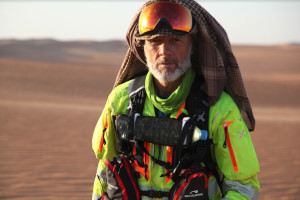
Max Calderan in The Lost Desert
Photos: Empty Quarter Studio
The Lost Desert, Empty Quarter Studio’s first feature length documentary, was acquired by STX and released last month on ad supported TubiTV.com. Most of the story takes place in Saudi Arabia’s Rub’ al Khali desert, where Max Calderan, an Italian extreme athlete, sets out to fulfill his lifelong dream: to walk 700 miles from west to east in an inhospitable uninhabited terrain.
An all male on the ground support team follows him in a caravan of vehicles, monitoring his well-being and filming. From idea to release the 83-minute film required four years of work. The company founders funded the project’s $1.2 million costs, hoping the film will appeal “to anyone who has big dreams and goes to any length to accomplish them. It will appeal to the elite sports athletes and fans, as well as people interested in natural history, science, culture and travel.”
“I met Max Calderan in 2016 and was immediately taken by his charisma, passion, and mission to accomplish his lifelong dream,” said Billy Sprague, president, Empty Quarter Studios, in a press release for the documentary. “I wanted to tell Max’s story and document his last, greatest challenge – to cross the largest sand desert in the world. I’m very proud of our film crew, who captured this inspiring story in one of the world’s harshest, deadliest, and most remote deserts. This is an inspiring story about a man pursuing his lifelong dream. It’s a story about perseverance and passion. And it’s a story about one of the least traveled to, most inhospitable places on earth.”
Described as having spent years crossing deserts on foot Calderan, a driven self-effacing athlete in his fifties, braved punishing heat (averaging 117 degrees Fahrenheit, according to promotional materials), shifting sand dunes of up to 1,000 feet as well as “poisonous snakes, spiders, scorpions, and any number of life-threatening challenges” in the making of the documentary. According to promotional materials, among Calderan’s eleven world records in desert exploration, he has run 90 hours straight without stopping in Oman. He also once ran 225 miles in 75 hours across a Saudi Arabian desert in summer.

Billy Sprague, president, Empty Quarter Studios
When asked about the greatest challenge the film presented Sprague said, “Transporting our crew and thousands of pounds of equipment and life-sustaining supplies in one of the most remote, dangerous, completely off-grid locations.” The greatest reward? “Successfully capturing the story and wrapping production in one of the most remote, dangerous, completely off-grid locations.”
The documentary was directed by Christopher Cassel. Michael Haertlein (Jane Goodall: The Hope) was director of photography, Marcelino Belizario (Bad Suns) handled Aerial Cinematography, Adriano Bravo (Human Weapon) was sound recordist, Benjamin Frank was assistant camera operator, and Rosie Walunas (But It Doesn’t Have Me) was editor.
Empty Quarter Studios, a New York and London based film and television production company, creates original non-fiction content “using moving images to tell epic, immersive and transformational stories borne out of exploration, travel, history, science and everyday life in the world’s most exotic and unreachable places” for global distribution.
Tubi, a division of Fox Entertainment, is an “ad-supported video-on-demand service with over 30,000 movies and TV shows, 65+ local and live news channels, and 250+ entertainment partners.” Stxfilms is a five year old division of Eros Stx Global Corporation, which “produces, acquires, distributes, and markets motion pictures at scale.”
Posted by Elena del Valle on June 30, 2021

The Latino Experience (from left to right) shorts: Body and Spirit in Times of the Pandemic, Pasos de Valor and The Blue Cape.
Video, photo: PBS SoCal
Southern California PBS station PBS SoCal and KCET is scheduled to air The Latino Experience, a three-part series of short films in English and Spanish, by Latino filmmakers beginning Tuesday July 6 and Wednesday July 7 at 9 p.m. P.T. Five of the 13 films were made by Southern California-based filmmakers. Two of the short films, Body and Spirit in Times of Pandemic; and The Daily War, are set in and around Los Angeles. Scroll down to watch a video trailer of The Daily War.
What criteria was used in selecting the films? “PBS announced a call for submissions for scripted and unscripted projects of all subjects, but were particularly interested in projects that focused on contemporary Latino/a/x culture produced and created by Latino/a/x persons,” a PBS spokesperson responded by email. Filmmakers were eligible for support grants between $5,000 and $25,000. She explained that “Successful submissions needed to include: a clear story arc; confirmed access to the story and participants; a unique perspective on contemporary Latino/a/x culture; an engaging formal and aesthetic approach.”
According to a press release the films for the series were selected ”by a panel of experienced filmmakers” from entries received by PBS following a call for submissions in August 2020. The press release also indicated “The shorts received funding support as well as a national broadcast as part of the series.” The names of the judges and their affiliations were not identified. Bill Gardner and Wendy Llinas are listed as executives in charge for PBS for the series.
When asked what channels PBS used to announce its search for submissions the PBS spokesperson said,”PBS announced the project on PBS.org, through social media, and through their network of member stations. In addition, PBS producing partners such as Latino Public Broadcasting and NALIP also shared the announcement.”
PBS received more than 240 entries. PBS decision makers expanded the series to three hours from the two-hour special they had planned to accommodate “the overwhelming response to the call for submissions.”
When asked to identify the source(s) of funding (public, private, which grants) the spokesperson replied, “The Latino Experience was funded by PBS. Additional funders contributed to the production of some of the individual films.”
Some of the films of the series are: The Blue Cape written, directed and produced by Alejandra López and produced by María José Delgado; Body and Spirit in Times of Pandemic directed and produced by Andrés Caballero; Pasos de Valor written, directed and produced by Natalia C. Bell; The Daily War, a co-production with Latino Public Broadcasting (LPB), directed and produced by Karla Legaspy and co-produced and written by Adelina Anthony; Noche Buena written, directed and produced by Andres Rovira. It was also produced by (and starring) Ray Tezanos.
Posted by Elena del Valle on May 26, 2021

It’s Not A Burden poster
Photo, video: Greenie Films
It’s Not A Burden The Humor and Heartache of Raising Elderly Parents, a new 90-minute documentary from Michelle Boyaner and Greenie Films spotlights the issues faced by the adult children of several elderly people. Some of them are living in assisted living facilities, some with dementia and or debilitating health conditions; some had passed away by the time the film was made. Boyaner and her mother feature prominently, often in video taken in the car. The emotionally charged 2020 film features candid conversations with the adult caregivers and their parents in several locations in California as well as Arizona, Georgia, Massachusetts and New Jersey. Scroll down to watch a short video introduction.
“Sometimes I pretend like she’s somebody else’s mother and that way I can be nicer to her,” Boyaner, who had been estranged from her mother until she made a promise to look after her to her sister, says in the documentary.
A bit later in the documentary one of the adult women who is her mother’s full-time caregiver asks, “Who’s going to take care of me?” when she gets old like her mother since she has no children. The producers found participants among their circle of friends and their friends. When asked about the goal of the documentary a spokesperson explained by phone that they hoped to remind viewers that when they look at their aged parents they remember who they were and that they are still those same people inside.
Made with the fiscal support of The Film Collaborative and Kickstarter funding. The film was written, directed and produced by Emmy®-nominated filmmaker Boyaner (Packed in a Trunk: The Lost Art of Edith Lake Wilkinson). Barbara Green (A Finished Life: The Goodbye and No Regrets Tour) served as cinematographer, editor and producer. Katie Ford (Miss Congeniality) and Wendy Zipes Hunter (Voices of Parkland) were producers. The original score composed by Joanna Katcher (Nice Manners) featuring songs by Danielle Ate The Sandwich. Maxine Lapiduss, Aaron Lustig and Barb Held were executive producers.
Gravitas Ventures (North American), a Red Arrow Studios Company, will distribute the documentary due to be released on video on demand (VOD) in the United States June 1, 2021 on iTunes, Vudu, Google Play, and Vimeo.
Posted by Elena del Valle on January 19, 2021

The Climate Crisis Font English language landing page – click to enlarge
Video, photos: Helsingin Sanomat
Photo Tuomas Jääskeläinen: Juha Törmälä
Helsingin Sanomat
, “the biggest subscription-based newspaper in the Nordics,” dedicated several weeks of work spread over months to the development of The Climate Crisis Font designed to visualize the urgency for climate action. The new font is available for download free of charge at TypeToAct.com. Scroll down to watch an English language video.
“The font has been licensed with SIL Open Font licensing making it available for editorial, commercial, and private use,” said Tuomas Jääskeläinen, art director, Helsingin Sanomat, in response to questions through a communications intermediary via email.” The full terms of use are available at drive.google.com/file/d/19M8ebCT0JOLWln6LDkWQzj5gy-qmj9Ww/view.
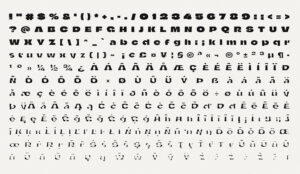
The Climate Crisis Font designed to visualize the urgency for climate action – click to enlarge
“The main limitation is that it needs to be kept freely available and free of charge,” he said. “The font is intended for anyone who wishes to make a point about the impact of climate change, be it the media, designers, artists, activists or anyone else.” He explained that “the font has been designed to work in all latin-based alphabets when it comes to e.g. diacritics.
.
When asked other than drawing attention to climate action what makes the font special or distinctive he replied: “
I think it’s the fact that it’s based on actual data. We haven’t done a massive search, but I suspect it’s among the first data-based fonts in the world, if not the first. That, and the way the scalable OpenType technology lets the font align with the yearly data, is what makes it special for me.”
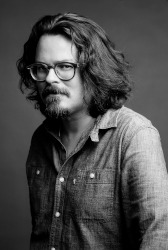
Tuomas Jääskeläinen, art director, Helsingin Sanomat
Regarding the budget or budget range for the creation of the font he said: “
Unfortunately I cannot disclose the budget, but it is a reasonable investment considering the scope of work needed.”
Helsingin Sanomat, a private for profit entity, is published by Sanoma Media Finland, a leading Finnish multi-channel media company. The paper’s primary language is Finnish.
Posted by Elena del Valle on October 28, 2020
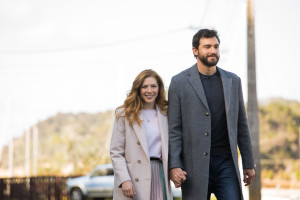
Rachelle Lefevre and Matt Whelan play a Canadian couple in The Sounds
Photo: Acorn TV
Video: South Pacific Pictures
Rachelle Lefevre and Matt Whelan play Maggie and Tom Cabbott, a Canadian couple in The Sounds, a psychological thriller from Shaftesbury in Canada and South Pacific Pictures in New Zealand. When Tom disappears, dark secrets and family plots complicate matters for Maggie. The TV miniseries is available in the United States via Acorn TV, a commercial free subscription streaming service offering foreign programing. Scroll down to watch a video trailers.
In the eight episode miniseries the happily married Canadian couple start a new life and a new salmon fishery business in a small harbor town. What starts as a promising adventure for the couple seeking to escape Tom’s oppressive family quickly spirals into an unsettling story.
“It was made for Acorn TV and CBC and Sky TV NZ,” said Rachael Keereweer, head of Communications, South Pacific Pictures. “The primary target audience here in New Zealand was a relatively broad, 25-54 demo. From idea, the show was several years in the making. The actual production schedule, including pre-production was 6 1/2 months with a shoot period of 13 weeks from mid-August to late November 2019.”
The visually stunning background scenery in The Sounds is in New Zealand. The series was filmed in Whangaroa at the top of the North Island in an area called the Bay of Islands and in Auckland.
“It’s a mystical, magical, wonderful, beautiful place,” said Lefevre about the Malborough Sounds in a series press kit. And when asked about the most enjoyable aspect of working on The Sounds Whelan said, according to the same promotional materials, “Shooting up North in Whangaroa, I’d never been there before and spending a couple of weeks out on the water, on yachts and kayaking and doing all sorts of cool things in beautiful locations around New Zealand.”
The program was created and written by Sarah-Kate Lynch (Blessed Are the Cheesemakers, The House of Daughters). Other creative staff include Peter Stebbings, director, and executive producers Kelly Martin and Sally Campbell.
South Pacific Pictures, in operation for 32 years, has produced more than 5,600 hours of drama series and serials, feature films, reality programming and documentaries for New Zealand, Australian, Canadian and United Kingdom broadcasters, according to the company website.
Shaftesbury is a Toronto based creator and producer of original content for television, film, and digital content, according to the company website. That includes 13 seasons of Murdoch Mysteries, three seasons of Frankie Drake Mysteries, three seasons of Slasher, Hudson & Rex, Departure, Dead Still, and The Sounds.
Posted by Elena del Valle on September 17, 2020

Light and Space
Photo, video: KECT
For serious art lovers California PBS station KCET will premier the eleventh season of Artbound at 9 p.m. P.T. Wednesday September 30. The hour long program featuring three artists and their work will focus on The Light and Space movement of a group of artists in California in the 1960s who explored minimalism with attention to the interaction of light and space. The materials the artists relied on to create their “perceptual experiences,” such as polyurethane, fiberglass and plastics, emerged from the postwar aerospace industry. The artists are Robert Irwin, Larry Bell, and Helen Pashgian. Primary production was December 2019 to February 2020. Scroll down to watch a video preview.
Artbound is an Emmy award-winning arts and culture series that examines the lives and works of arts of culture innovators, especially those making an impact in Southern California. The first episode will air again at 8 p.m. P.T. on Friday October 2 on PBS SoCal and at 10 p.m. E.T./P.T. Tuesday October 6 on Link TV (DirecTV channel 375 / Dish Network channel 9410). The episodes should also be available for online streaming following their initial broadcast on kcet.org/artbound, pbssocal.org/artbound and linktv.org/artbound as well as on Amazon, YouTube, Roku, Apple TV and the free PBS App.
Video

























